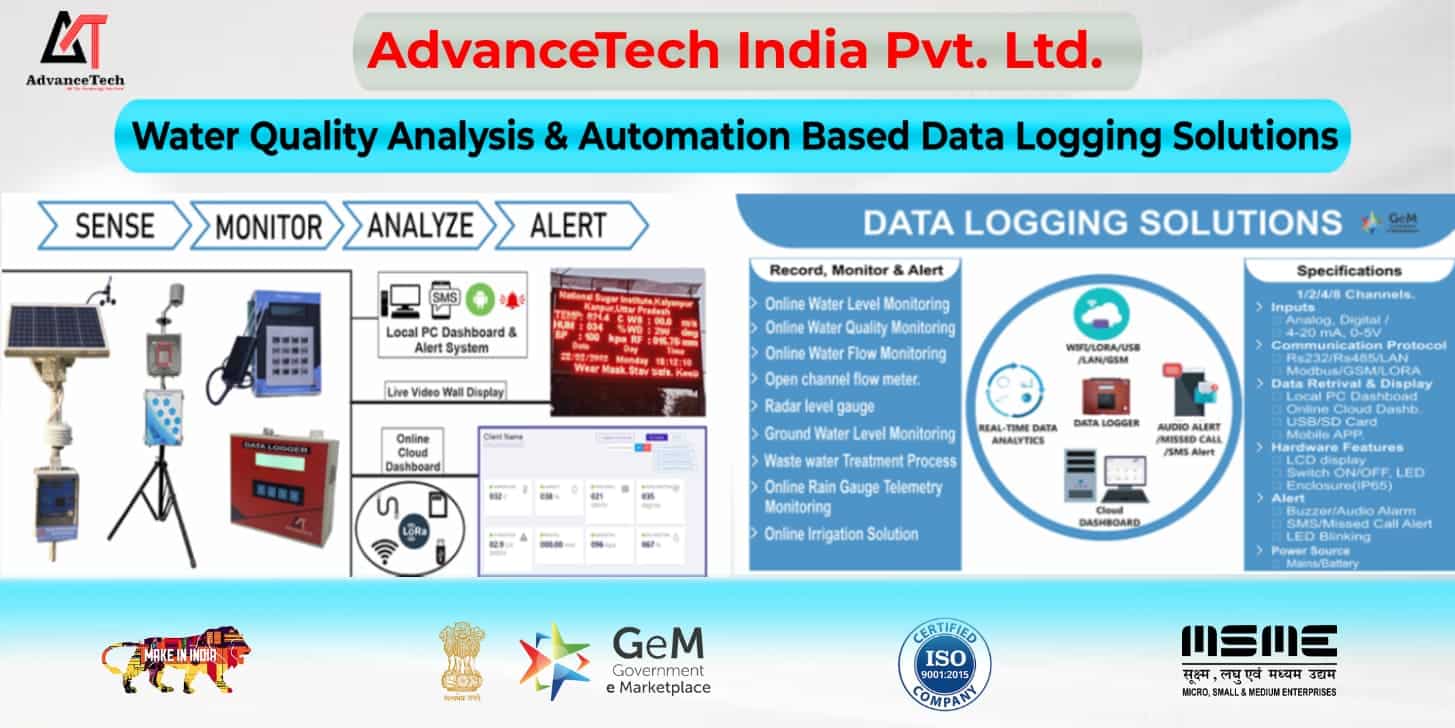AdvanceTech India has the experience of undergoing multiple water quality monitoring and analysis automation systems. We have done complex projects for IIT Kharagpur, West Bengal Government, Central Water Commission (CWC), Irrigation Department, and many other renowned organizations working in the same field. We Design IoT Based Data Logging, Sensor Interfacing Dashboards on the cloud with Analysis. Multiple Parameters like pH, TDS, Dissolved Oxygen, Fluorides, and many other parameters can be covered.
Smart Water Quality Monitoring Systems: Water is necessary for life, and maintaining its purity is also most important for the health and welfare of communities everywhere. Unfortunately, the safety of our water resources is in danger by pollutants and pollution in the water. As a result, Advanced technologies like smart water quality monitoring systems have surfaced, offering effective real-time data collecting and analysis to safeguard water quality. This blog examines the developments, types, and sensor technologies that are propelling the field of smart water quality monitoring systems forward.

Table of Contents
ToggleEvolution of Water Monitoring
In the past, routine sampling and laboratory analysis were required for regular water quality monitoring. These procedures were time taken as well as produced data slowly. Smart Water Quality Monitoring Systems, on the other hand, have completely changed the face of water management due to advanced technology breakthroughs. These systems provide constant observation, making it possible to identify pollutants right away and take protective action to protect the quality of the water.
Types of Smart Water Quality Monitoring Systems
There are two main types of smart water quality monitoring systems first one is portable and another one is stationary. Installed at fixed places including lakes, rivers, and water treatment facilities, stationary systems continuously monitor water quality parameters in real-time. On the other hand, portable systems are wearable or handheld gadgets that allow for mobile water quality monitoring; they are perfect for field measurements and quick evaluations of water bodies.
Component Description of Water Quality Monitoring System
There are different components of a water quality monitoring system and the functionality of these components is different these components are mentioned below:
Data Acquisition System (Data Logger)
Data Logger is used for recording, sensing, analyzing, and alerting the user on based of the parameters received by it. Data is recorded over time or about the location by Data Loggers, either with a built-in instrument or sensor or via external instruments and sensors. Data Logger can also be custom-built depending upon the requirements like type of display, number of channels, power source, sample rate offset settings, etc. Data Loggers are connected to sensors and act as computing brain for complete solution.
Turbidity Sensor
The turbidity sensor head is connected at the top of the sensor which is connected to the processing unit, we can connect and remove it easily. The voltage of the turbidity sensor is 3.3-5V DC.
Temperature Sensor
An Internet of Things (IoT) based smart water quality monitoring system that uses a temperature sensor can track variations in water temperature over time. This can assist experts in water quality in determining if the water is safe to drink and whether any special measures are required. This is a device which is used to measure the temperature. As this is a water temperature sensor so it is waterproof.
These sensors are suitable for installation in lakes, rivers, and other bodies of water. They can send real-time data to a central monitoring system. A central control unit processes the data gathered by the sensors and offers real-time feedback on the water’s quantity and quality.
ESP 32
The ESP32 reads the values from the sensors to determine the water’s pollution level. The objective of this water quality monitoring system using IoT is to find the quality of the water. Water pollution is the biggest problem. One of the key factors influencing health and the condition of illnesses “around kin and animals” may be water personal satisfaction. Lakes and rivers are those basic sources of drinking water, which are remarkably dependent on the physical and chemical qualities of water. Variations in pH content are conveyed to the appropriate authorities. This project will be implemented at drinking water reservoirs and municipal water tanks. To find the pH value for that, we use an ESP32 board. Ultimately, the user receives data on the pH value from the sensor to the cloud for worldwide water quality monitoring.
pH Converters
pH converters are beneficial in smart water quality monitoring systems. Current time observation is only possible because of ph convertors in smart water quality monitoring systems with IoT. These converters always provide accurate output. The exact estimate of sourness of high pH is possible only because of these pH convertors.
TDS(Total Dissolved Solids) Converters
This is another component of a smart water quality monitoring system that enables real-time keep under observation with IoT(Internet of Things). Exact measurement of mixed matter is only possible by these converters. The results are always accurate and reliable which are generated through TDS converters.
Conclusion
Water is an essential thing for everyone and the purity of the water is another important factor that needs to be discussed. In that case, the smart water quality monitoring system plays a lead role as well as its necessary components ph convertor, TDS converters, ESP32, Temperature Sensor, Turbidity Sensor, and all of its components. All these components has the ability to change the quality of the water so that everyone can use safe, clean, and pure water. As there are two types of smart water quality monitoring systems we can use any of the types according to our requirements.







